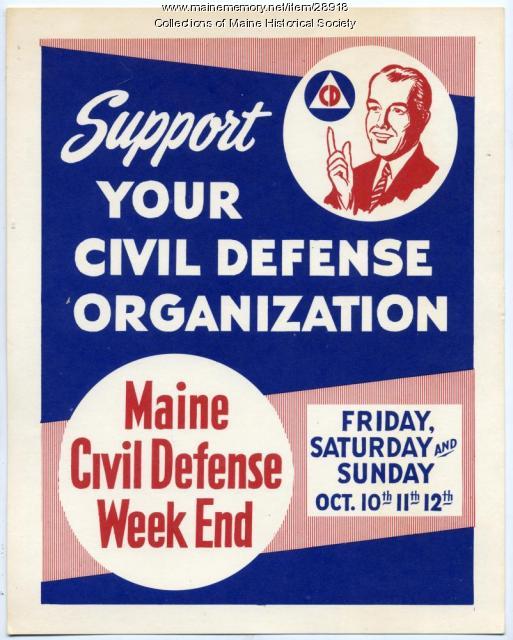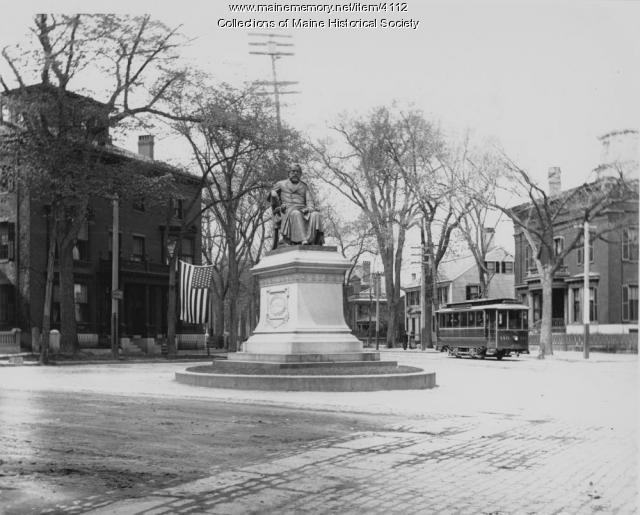Keywords: Motive
Item 10407
Special Stopped at Squa Pan, ca. 1955
Contributed by: Oakfield Historical Society Date: circa 1955 Location: Squa Pan Media: Photographic print
Item 14468
Trial Paint Scheme, Bangor and Aroostook F-3, ca. 1972
Contributed by: Oakfield Historical Society Date: circa 1972 Media: Photographic print
Exhibit
Civil Defense: Fear and Safety
In the 1950s and the 1960s, Maine's Civil Defense effort focused on preparedness for hurricanes, floods and other natural disasters and a more global concern, nuclear war. Civil Defense materials urged awareness, along with measures like storing food and other staple items and preparing underground or other shelters.
Exhibit
Father Rasles, the Indians and the English
Father Sebastien Rasle, a French Jesuit, ran a mission for Indians at Norridgewock and, many English settlers believed, encouraged Indian resistance to English settlement. He was killed in a raid on the mission in 1724 that resulted in the remaining Indians fleeing for Canada.
Site Page
Presque Isle: The Star City - Bangor and Aroostook GP-38, Presque Isle, 1991
"… last GP-38 purchased from General Motors Electro-motive Division (EMD), was delivered in September 1967."
Site Page
Portland Press Herald Glass Negative Collection - "Twenty Nationalities, But All Americans"
"… government and the rise of the Ku Klux Klan were motivated by anti-immigrant sentiments. In response to the charge that immigrants could never…"
Story
Creating the Purr-Sist button
by Ellen Crocker
Motivated by the Women's March and Sen. Warren, I created these buttons
Story
Isolation!
by Leslie
Having only moved to Maine alone 8 months prior, had to freeze my life
Lesson Plan
Longfellow Studies: An American Studies Approach to Henry Wadsworth Longfellow
Grade Level: 6-8, 9-12
Content Area: English Language Arts, Social Studies
Henry Wadsworth Longfellow was truly a man of his time and of his nation; this native of Portland, Maine and graduate of Bowdoin College in Brunswick, Maine became an American icon. Lines from his poems intersperse our daily speech and the characters of his long narrative poems have become part of American myth. Longfellow's fame was international; scholars, politicians, heads-of-state and everyday people read and memorized his poems. Our goal is to show that just as Longfellow reacted to and participated in his times, so his poetry participated in shaping and defining American culture and literature.
The following unit plan introduces and demonstrates an American Studies approach to the life and work of Longfellow. Because the collaborative work that forms the basis for this unit was partially responsible for leading the two of us to complete the American & New England Studies Masters program at University of Southern Maine, we returned there for a working definition of "American Studies approach" as it applies to the grade level classroom. Joe Conforti, who was director at the time we both went through the program, offered some useful clarifying comments and explanation. He reminded us that such a focus provides a holistic approach to the life and work of an author. It sets a work of literature in a broad cultural and historical context as well as in the context of the poet's life. The aim of an American Studies approach is to "broaden the context of a work to illuminate the American past" (Conforti) for your students.
We have found this approach to have multiple benefits at the classroom and research level. It brings the poems and the poet alive for students and connects with other curricular work, especially social studies. When linked with a Maine history unit, it helps to place Portland and Maine in an historical and cultural context. It also provides an inviting atmosphere for the in-depth study of the mechanics of Longfellow's poetry.
What follows is a set of lesson plans that form a unit of study. The biographical "anchor" that we have used for this unit is an out-of-print biography An American Bard: The story of Henry Wadsworth Longfellow, by Ruth Langland Holberg, Thomas Y. Crowell & Company, c1963. Permission has been requested to make this work available as a downloadable file off this web page, but in the meantime, used copies are readily and cheaply available from various vendors. The poem we have chosen to demonstrate our approach is "Paul Revere's Ride." The worksheets were developed by Judy Donahue, the explanatory essays researched and written by the two of us, and our sources are cited below. We have also included a list of helpful links. When possible we have included helpful material in text format, or have supplied site links. Our complete unit includes other Longfellow poems with the same approach, but in the interest of time and space, they are not included. Please feel free to contact us with questions and comments.
Lesson Plan
Longfellow Studies: "Christmas Bells"
Grade Level: 6-8, 9-12
Content Area: English Language Arts, Social Studies
The words of this poem are more commonly known as the lyrics to a popular Christmas Carol of the same title. Henry Wadsworth Longfellow wrote "Christmas Bells" in December of 1863 as the Civil War raged. It expresses his perpetual optimism and hope for the future of mankind. The poem's lively rhythm, simple rhyme and upbeat refrain have assured its popularity through the years.














